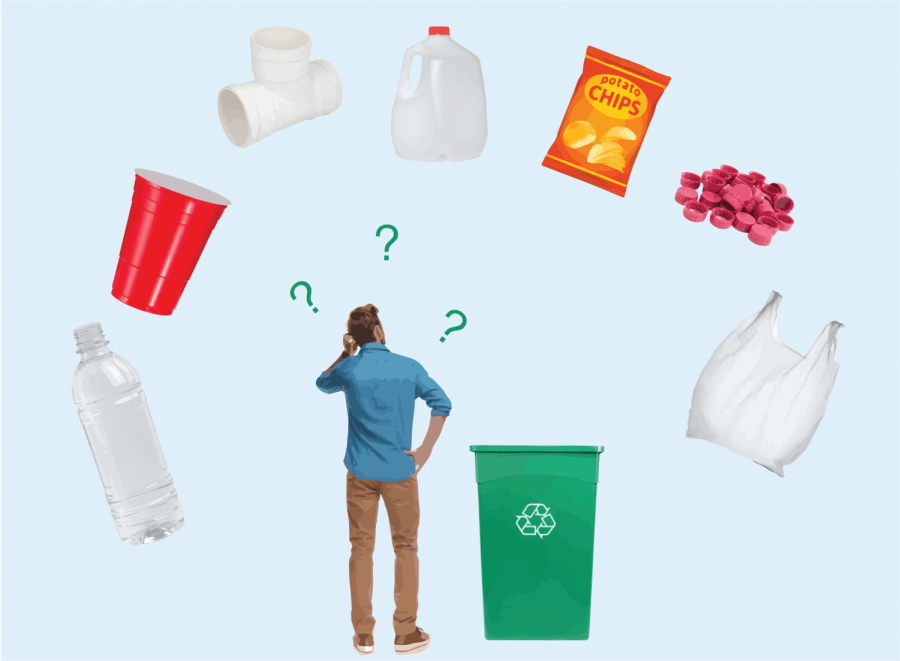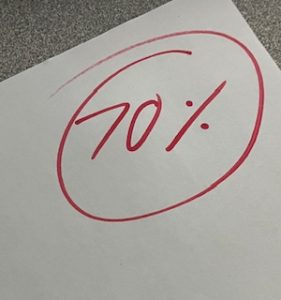Looking Behind the Veil of Plastic Recycling
June 4, 2021
We are all passively acquainted with the blue bin. It patiently waits in every classroom and cafeteria and on every curb. It tempts us with the idea of sustainability by broadcasting the “chasing arrows” logo. Over time, recycling has established itself as the face of the globally recognized triad: reduce, reuse, recycle.
And this is understandable, for there are many tangible benefits to recycling. By recycling aluminum cans, we can save 95% of the energy needed to make cans from newly harvested raw materials. Furthermore, by recycling steel, tin cans, paper, plastic and glass, we can save 60 to 74%, 60%, and 33% of the energy needed to make the products out of new material, respectively. By evading the need to extract raw materials, we also reduce the amount of fossil fuels we consume.
Another benefit of recycling is the reduction in carbon dioxide emissions. About 46 million tons of paper and paperboard that were recycled in 2018 reduced our carbon dioxide output by over 155 million metric tons of CO2 equivalent—the same as removing 33 million cars from the road for one year.
Recycling also commands a portion of the economy, providing 681,000 jobs, paying $37.8 billion in wages and providing $5.5 billion in tax revenues.
So, when you ask yourself “Is this even worth it?” as you meticulously collect your junk mail, flatten your cardboard boxes and wash out your glass jars, oftentimes, the answer is ‘yes.’
But there is an exception to every rule, and in this case, the anomaly is plastic.
A Rise to Fame
Plastic has methodically wedged itself into every crevice of our lives and the planet. It is estimated that Americans use 100 billion plastic shopping bags every year, contributing to the one trillion bags used worldwide—an astonishing magnitude for a product used for an average of 12 minutes.
From clothes and construction to medical equipment and electronics, plastics have almost subliminally infiltrated society. But this take-over was not subconscious. It was deliberate.
Plastic production was largely catalyzed by WWII, as Nylon was used to make parachutes and body armor while Plexiglass found itself in aircraft windows. This demand for “the material of a thousand uses” pushed plastic production up by 300% in the United States alone.
Plastic’s unstoppable momentum enabled its swift domestication following the war. Every factory utilized for military purposes found a new target audience: us.
Suddenly, the undertone of everything in our house, school, workplace and environment was a subtle shade of plastic.
With this omniscient wave of plastic came a nationwide reckoning against it, putting a dent into the industry’s previously unbreakable image of convenience and materialistic fantasy. Plastics added flame to the fire of the environmental movement in the 1970s, as plastic pollution spread to the sea, and littered our parks, sidewalks and coasts.
With reputation at stake, the plastics industry desperately needed a way out. Their chance came in the form of an unlikely ally: recycling.
Lies Unfold and Unravel
In 1988, plastic manufacturers came together to create the Council for Solid Waste Solutions. This coalition started a pilot plastic recycling program, which was intended to frame plastics as a sustainable product that could blend into the greenwashed background. Perhaps this campaign would have been an elegant solution if it wasn’t a lie.
Back in the 1970s, when plastic’s reputation hung in the balance, plastic companies were aware that plastic could not be profitably recycled. The crux of the problem was that the demand for recycled plastic just wasn’t high enough to compete with new plastic. This is in large part due to the fact that petroleum is abundant and inexpensive, thereby making the production of new plastic cheaper than the extensive process of recycling plastic.
Currently, the U.S. is one of the cheapest places to produce new plastic.
Since the market for recycled plastic is almost nonexistent, only 9% of all plastic ever produced has been recycled. In fact, the U.S. burns six times more plastic than it recycles, with 76% of all plastic ending up in landfills.
This is why, even in the midst of hopeful plastic recycling on the part of consumers, 80% of all marine debris is plastic, according to the International Union for Conservation of Nature, and it is estimated that by 2040, 29 million tons of plastic will choke our oceans every year, according to a study published by Pew Trusts, an independent non-profit. But this blatant reality was not only hidden. It was also exacerbated by the arrival of an unsuspecting foe: resin identification codes.
These codes, numbered 1 through 7, are found on every piece of plastic packaging. The best way to recognize them is to look for a tiny number nestled in the “chasing arrows,” the image we all associate with recycling. Every number represents a different category of plastic. For example, if you see the number one on the bottom of a container for your blueberries, that means the plastic used in that packaging is polyethylene terephthalate or PET. This is the type of plastic used to make plastic water bottles and soda bottles, and it is also the most commonly recycled plastic. About 30% of PET plastic is recycled. But this is misleading because only water bottles and soda bottles are usually recycled in this category. Those clamshell containers lining the produce section of every supermarket are also in the PET category, but unlike its bottle relatives, they are rarely recycled.
Since the market for recycled plastic is almost nonexistent, only 9% of all plastic ever produced has been recycled. In fact, the U.S. burns six times more plastic than it recycles, with 76% of all plastic ending up in landfills.
The only other plastic category that has a similar rate of being recycled is number two: HDPE. This category contains opaque plastics, such as the ones used for milk jugs.
Essentially, only a portion of two out of the seven plastic categories actually make it to the recycling finish line. However, since the resin codes are put in the triangular recycling logo, every type of plastic that has a number on it gets mistakenly recycled by consumers who are trying to do the right thing.
This deliberate tactic of deception helped sustain the lie that every plastic product had the potential to end up as the same product or turned into something new, such as construction material or clothing. Yet, even the profitable plastic can only be recycled once or twice before ending up in a landfill anyway.
So how do we, as consumers, fight this endless production of plastic when only a tiny sliver gets recycled? Well, the answer is simple: we cannot. At least not in the status quo. The power of the consumer is limited when you realize that energy companies have invested more than $200 billion in 333 plastic and chemical projects in the United States since 2010, according to the American Chemistry Council, an industry trade association that represents plastics manufacturers in its Plastics Division.
But amidst this vicious cycle, our voice can still be heard. There are still solutions available for us to collectively advocate for.
Where Our Power Resides
Extended producer responsibility legislation is one such solution. The concept behind EPR is that producers must be held accountable for the entire life cycle of their product, from manufacturing to waste management. This would force producers to design their products in a way that it can be easily recovered, setting the foundation for a circular economy. The Northern Virginia Waste Management Board outlined their case for EPR legislation in a 2021 report in which they stated that 84% of localities surveyed in 2017 supported more producer responsibility when it comes to difficult-to-handle products, which includes food and beverage container packaging. By passing EPR laws, governments can enforce companies’ adherence and ensure transparency throughout the entire process.
This approach to waste management also alleviates the strain on local governments to properly dispose of products that were packaged in a way that isn’t conducive to recycling to begin with. However, entire communities must start voicing their support of EPR laws to elected officials if we are to instill a sense of urgency in the policymaking process. We can also support organizations like the Ellen MacArthur Foundation, which is working with industries to design products that fit into a circular economy where no waste can pollute the environment.
Opening our eyes to what other countries are doing to deal with the constant influx of plastic is also imperative. Norway recovers 97 percent of all plastic bottles by employing a simple incentive: for every bottle returned to machines stationed at supermarkets, you get a 32 cent refund. When Germany implemented a nationwide bottle deposit requirement, it saw recycling rates soar to above 98 percent. For a comparison closer to home, it is estimated that plastic bottles and cans account for 22% of litter in Virginia, while the rate is less than 9% in states with container deposit bills.
Another strategy is to implement a tax on single-use plastic bags. A tax was considered by the Loudoun County Board of Supervisors in Fall 2020 when the General Assembly first awarded localities the ability to levy a 5-cent tax on plastic bags. However, the Board decided not to formally consider the tax until 2022, when the financial burden of the pandemic would hopefully be lessened. When the U.K. instated a tax on plastic bags, it saw usage drop by 80%.
There have also been recent legislative triumphs regarding plastic pollution in our state. On March 23, 2021, Governor Ralph Northam signed Executive Order 77, which mandated that within 120 days of the order’s issuance, executive branch state agencies, state institutions of higher educations, and their concessioners must halt the purchase, sale, or distribution of disposable plastic bags, single-use plastic and polystyrene food containers, plastic straws and cutlery, and single-use plastic water bottles.
Furthermore, the order stated that within 180 days from issuance, each executive branch agency must develop a State Agency Plastic Pollution Reduction Plan that outlines how the buying, selling, or distribution of all nonmedical single-use plastic and expanded polystyrene products will be eliminated and replaced with reusable, compostable, or recyclable items. It is stated that the phasing out process will be completed by Dec. 31, 2025.
But for some, policy issues and legislation are too far removed from daily life. The good news is that you can still make an impact in your small sphere of influence. One simple step is becoming aware of the types of plastic that your locality collects for recycling. By being informed, you can ensure that you are properly recycling the few types of plastic that your curbside recycling program accepts. In Loudoun County, residents can place plastic bottles, jars, tubs, and cups loosely into the blue bin.
The last call to action is probably the most obvious yet the hardest to adhere to: reducing plastic consumption. About 50% of all plastic produced is thrown away after just one use. Plastic litter is strewn as carelessly on our sidewalks as it is on the ocean floor. Microplastics are becoming the alter ego of plankton as they bio-accumulate up the food chain and end up in our seafood. The U.S. exports 25 million tons of scrap plastic to poorer countries across the globe, including Malaysia and Indonesia. Large ocean small island developing states (LOSEDS) and Pacific islands bear the brunt of plastic pollution due to their reliance on imported goods that are often shrouded in plastic packaging, lack of adequate recycling facilities, and limited waste management capacity. We must reduce our reliance on plastic packaging by taking manageable steps, such as reusing a product for as long as possible, buying in bulk when possible, and choosing secondhand items over new ones.
Small actions matter. Besides, the plastics industry started with one idea. We, as a community, can also start a movement to combat it. We must.







